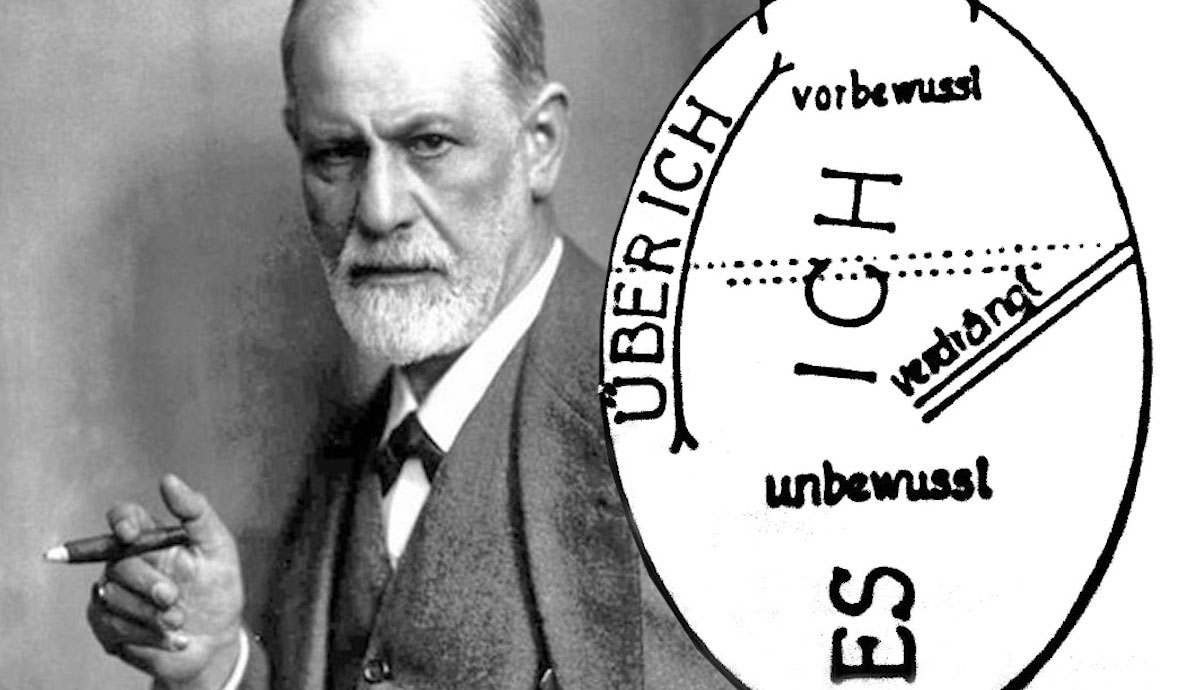
The Superego is one of Sigmund Freud’s most popular concepts. It represents a part of the self that arises from the internalization of cultural rules, mainly as taught by parents. However, other authority figures play a role in this as well, and so does society as a whole. Therefore, even if the Superego is a part of the individual, its roots are to be found in society and other people. In this article, we’re going to explain why the Superego is inherently social and how it shapes our interactions.
Id, Ego, and Superego: Freud’s Model of the Psyche explained

To explain what the Superego is, we should first introduce Freud’s structural model of the psyche. According to Freud, our psyche is defined by three distinct and interacting agents: Id, Ego, and Superego.
The Id represents the instinctual part of our personality, and it exists from the moment we are born. It is unconscious and it only acts according to the pleasure principle, as it only aims to satisfy its drives (something similar can be found in Schopenhauer’s work).
The Id is where our libido is stored, so to speak. The Id seeks pleasure, often intended as sexual pleasure (that’s also where love stems from, though, so you can add Freud’s theory to the ever-growing list of philosophy theories about love). In his later writings, Freud introduced another “drive” for the Id, that is, the death drive. We are not going to explore this topic specifically in this article, as it adds a whole other layer of complexity to the Id.
As we said, the Id is the first part of our psyche from a developmental point of view. The Ego and the Superego can only exist after the Id, according to Freud.
The Ego is born from the interaction between the Id and the external world. It arises from the necessity the Id faces to compromise with the external world. That’s why the Ego follows the reality principle. The Ego still seeks pleasure, but it also tries to reach a balance between the uncontrollable drives of the Id (which remain unconscious) and the limitations imposed by the external world.

Lastly, the Superego could be defined as something akin to what we commonly refer to as “conscience.” The Superego is, just like the Ego, a product of the interaction with the external world, even though it has a completely different task. The Superego acts like a bridge between the Id and the Ego: it allows some drives and desires from the Id to reach the Ego, thus becoming conscious, and it represses other desires, leaving them forever confined in the unconscious world (except for dreams, where some repressed feelings may be expressed—but that is a different story we are not looking at today).
The Formation of the Id and the Ego

We are now aware of what the Superego is. However, we still need to understand what is the process that brings it to life. To be fair, we already briefly mentioned it, but let us take a deeper look at how the self develops according to Freud.
The first part of the psyche that comes to life is the Id. The Id is the instinctual part of the self: it stores our basic instincts, desires, and needs. When we are born, the Id is the only part of the self that exists. That is why the child only seeks to fulfill their needs. They feel hunger, pain, thirst, and so on. Every time the child feels a new need, they strive to fulfill it immediately. That is because the child does not yet have a rational side of the psyche. They are not yet accustomed to waiting and postponing the fulfillment of his needs.
However, the child will soon learn that the external world is not revolving around them. For example, their mother cannot always be around to feed them. And that is basically where, soon after birth, the Ego comes from.
The Ego grants the child his rational side of the psyche. Now the child knows that, even if their mother is not around at the moment, she will come back later and she will feed them at one point. This mechanism is simple, and yet fundamental in the economy of the psyche. The Id and the Ego represent two opposites, pure instinct versus pure rationality.
The Formation of the Superego

The Superego is the last part of the psyche to develop. Its birth still happens during infancy, as it takes shape during the child’s 1-5 years old timespan. However, it can only happen after both the Id and the Ego have developed.
What makes the Superego different from both the Id and the Ego is that the Superego is not something that stems from the child’s mind alone. The Superego arises from the context the child lives in. The Superego incorporates all the values, morals, and cultural norms that are taught by parents, teachers, and society as a whole (the importance of parenting and education was already a topic for ancient philosophers as well).
Let’s take a simple rule that parents teach their children: stealing is wrong. The Superego will incorporate this teaching, and it will try to make sure that the Id does not break that rule to reach its needs.
The Superego acts as a sort of mediator between the Id and the Ego. It acts as a filter, too. There are some desires that society forbids entirely; the Superego keeps those desires in the Id, so that they remain forever unconscious, except in dreams.
The most widely known example is the child’s incestuous desire for their parents (the Oedipus complex). But this is only the tip of the iceberg, especially in the society Freud knew. There are many other things that our society considers forbidden. Early 20th-century Europe was very strict and repressive.
Now that we know what is the process that leads to the birth of the Superego, we can ask ourselves: what role does the Superego play in our everyday life?
The Social Nature of the Superego

What we can gather from all this is that the Superego is inherently social, in contrast to the Ego and the Id. The Superego only exists because we live in a society with many coded values and norms, which we need to respect if we want to fulfill our desires (as Freud would put it).
So, even if Freud’s work is focused on the individual’s psyche, the Superego is an inherently social component of our mind, which stems directly from the context we live in. This has many implications, both from a theoretical and a practical perspective.
First of all, since the Superego is born from our context, that means that it changes through time and space. Different cultural norms and values will likely produce different Superegos.

That is the great difference between the Id and the Ego. The Id and the Ego seem to be from any conditioning from the outside world: they are born the same in every space and every time. The same does not apply to the Superego: the Superego will take the shape of the culture that it lives in. That means that a strict society will produce a strict Superego, while a more permissive society will produce a more permissive Superego.
You can probably guess it, but the Superego revolves around two main emotions: guilt and shame. You cannot feel certain emotions, and you cannot think certain thoughts because the Superego would make you feel too guilty or ashamed for that. It is an extremely simplified picture of how the process works, but you can get the idea.
That is a really important point to stress because that is not so obvious by reading Freud’s work alone. Freud seems to place little emphasis on the Superego’s social nature; he appears to be more concerned with the role it plays within the individual. But knowing that the Superego reflects current cultural norms and values makes one understand the importance of the context the child grows up in. Moreover, this leads to our final question for this article: How does the Superego impact our lives and relationships?
The Role of the Superego in Our Life and Relationships

We have said that the Superego fundamentally plays two roles. It is a bridge between the Id and the Ego, but it is also a gatekeeper for all that forbidden content that is not allowed to reach our conscience. This latter task is the one that has a greater impact on our lives, according to Freud. That’s because the Superego will not allow us to realize some of the things that we feel in our Id. After all, they go against socially accepted norms.
For example: I may be so angry at one person that I want to beat them up, but if my Superego is strong enough, I will not even realize that my anger is so strong because I know that beating another person is socially perceived as wrong (and rightfully so!).
This may seem like a positive thing at first, but that’s not always the case. Even if Freud’s theory on this is now pretty much outdated (but it still influences our culture), we know for sure that not allowing oneself to experience an emotion can lead to negative effects on the mind.
Hence, even if our Superego allows us to live peacefully by following our society’s norms and rules, we cannot let it forbid us from feeling a given emotion. The goal should be to teach people how to deal with their emotions rather than just hiding them away.
The social origins of the Superego give us an important task, because it is up to us, as parents, teachers, or simply as human beings, to make other people know that there is nothing to be ashamed of for what you feel or think. It is how you act upon those feelings and thoughts that defines your value.










